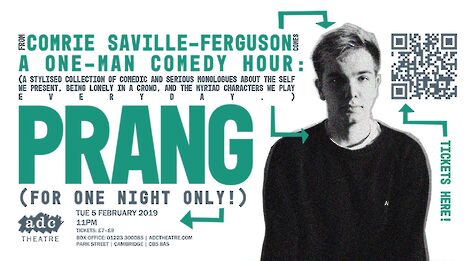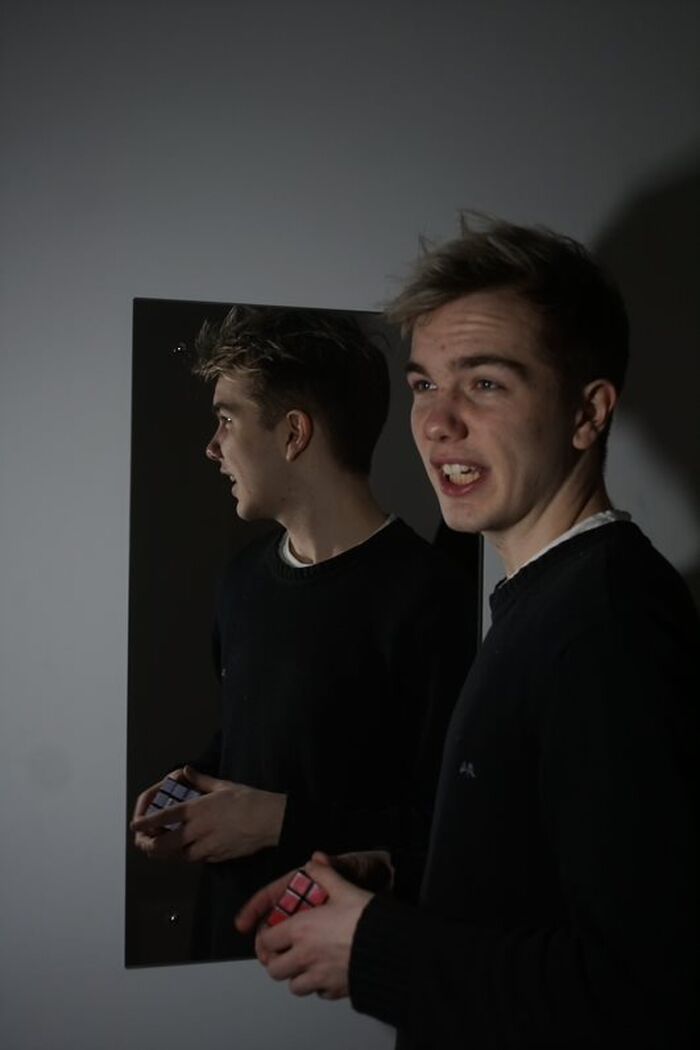‘Comrie Saville-Ferguson: Prang’ review
This fresh, experimental, and self-aware performance meshes comedy with sincerity to deliver a performance that is at once hilarious, relatable, and memorable

Comrie Saville-Ferguson opens Prang with infectious energy, and from that point on there’s not a single moment I’m bored. He flies from one sketch to the next, embodying characters ranging from an apathetic tennis player to a hermit to James Dyson, with accents to match. He seemingly effortlessly commands the stage, using his body to make us laugh just as much as he does his voice. And make no mistake, the laughter abounds. With this show, Saville-Ferguson succeeds in creating a highly enjoyable night of comedy – but he also does a lot more than that.
"It meshes absurd comedy with grave sincerity, using both to deliver a performance that is at once hilarious, relatable, and heart-breaking"
Prang consists of a series of sketches tied together by a narrative about a man named Steve, who takes part in an experiment that draws out the different instantiations of his personality in the aim of finding “the real Steve”. It is the attention to detail that allows the whole to come together as brilliantly as it does. The show is chock-full of references, many of which I probably missed. They include repeated mentions of Transformers and a stellar cameo from Dan Allum-Gruselle, who co-wrote last term’s pantomime with Saville-Ferguson (plus some fun appearances from Producer Amelia Hill). The wordplay throughout was met with resounding laughter – puns à la “Kazoosan Boyle” warming us up for Saville-Ferguson to actually play the kazoo. He gives not one but two full-on musical performances combining singing and dancing, that reminded me a little of Bo Burnham. His sketches continuously verge on the absurd as he plays on classic tropes and set-ups to subvert our expectations, right until the very end.
Lucia Revel-Chion (listed as ‘Tech God’) deserves praise for effectively incorporating multi-media into the show. Though this was the source of a number of slip-ups in execution, Saville-Ferguson handled them smoothly and professionally, drawing more laughs from the audience and working them into fourth wall-breaking jokes later on; for the most part, the audio-visual components blend seamlessly with his performance. The sound design is impressive, not only in terms of music but regarding a wide range of sounds that often serve as a core component of a joke. The screen too comes into play with impeccable timing: at one point, Saville-Ferguson’s miming to the sounds of gunshots and slashing swords is suddenly revealed to represent a game of fruit ninja. The transition between sketches, which involves a collage of videos of him, layered acapella-style into a catchy soundtrack, never gets old.
And then, Saville-Ferguson’s character Steve allows to spill from his lips: “I get sad”. He cuts through the noise with a line that lets us know his show isn’t all laughs – or rather, that his jokes are intertwined with the reality of what went into writing them. He delivers on this promise in the latter half, undercutting the hilarity (which still makes up the vast majority of the runtime) with notes of sincerity about mental health. The breakneck energy of most of the performance contrasts beautifully with these quieter moments, in which Saville-Ferguson captivates us with his story-telling. Yet that contrast is itself blurred: some of those stories then devolve into absurdity, returning us to the world of punchlines and self-deprecating humour. I found myself thinking the tech mishaps almost made the show stronger: as Steve encounters his anxiety face to face, or comments on the stress of Cambridge life, impostor syndrome, and the toll creating this piece of entertainment has taken on him, the fourth wall seems to disappear entirely. The raw emotion with which an 80-year old version of Saville-Ferguson speaks to his nephew (in other words the audience, in other words himself) is something I didn’t expect to see here, almost made me feel like I was intruding. Now I can’t imagine the show as complete without it.
The amount of thought and effort that went into Prang is phenomenal, and evident throughout. Fresh, experimental, and self-aware (see Saville-Ferguson’s own mid-sketch comment “Experimental theatre: it doesn’t always work”), it meshes absurd comedy with grave sincerity, using both to deliver a performance that is at once hilarious, relatable, and heart-breaking – and above all, memorable. Saville-Ferguson should be proud of what he has achieved with his debut stand-up hour. Towards the end, he lays out his motivation to his audience for standing in front of them: “When I’m on stage, I can make people happy.” Rest assured, you have.
 News / Uni Scout and Guide Club affirms trans inclusion 12 December 2025
News / Uni Scout and Guide Club affirms trans inclusion 12 December 2025 News / Cambridge Vet School gets lifeline year to stay accredited28 November 2025
News / Cambridge Vet School gets lifeline year to stay accredited28 November 2025 Science / Did your ex trip on King’s Parade? The science behind the ‘ick’12 December 2025
Science / Did your ex trip on King’s Parade? The science behind the ‘ick’12 December 2025 News / Cambridge study finds students learn better with notes than AI13 December 2025
News / Cambridge study finds students learn better with notes than AI13 December 2025 News / Pembroke to convert listed office building into accom9 December 2025
News / Pembroke to convert listed office building into accom9 December 2025








